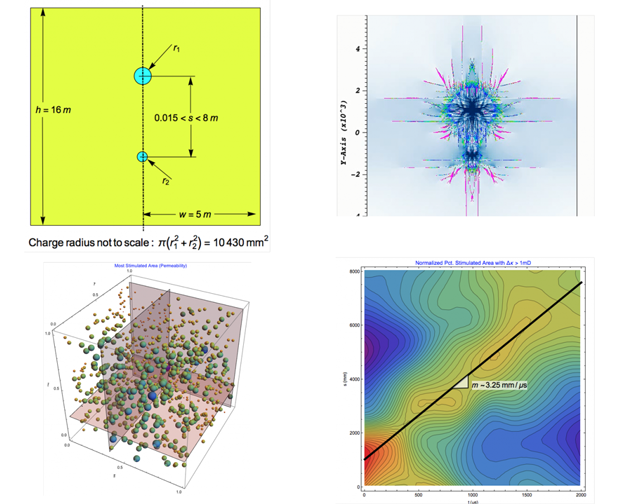Joseph Morris (15-ERD-010)
Abstract
Developments in horizontal drilling and hydraulic fracturing have resulted in a dramatic increase in gas and oil production in the United States. Increases in hydrocarbon extraction from unconventional resources have primarily come from shale gas and oil resources, where hydraulic fracturing is used to increase formation permeability and enable production. Despite technological successes, the vast majority of shale formations remain untapped because of an inability to effectively produce fracture networks in these types of shale. In these cases, as much as 90% of the resource is left in the ground, some formations cannot be produced, and water availability precludes hydraulic fracturing in water-stressed regions. Dynamic stimulation of reservoirs using energetic materials provides a possible alternative to hydraulic fracturing. Enhancement of fracture network connectivity via dynamic stimulation must consider the rate at which energy is released and the peak pressures generated, in addition to the geometry and temporal sequencing of explosive detonations. We plan to develop the necessary computational tools to allow the design of dynamic stimulation. We will perform simulations to determine the efficacy of dynamic stimulation as a function of rock type, in situ stress, pre-existing fracture network, energetic materials, and detonation geometry.
We expect to develop a modeling capability for the design of dynamic stimulation procedures to enhance hydrocarbon resource recovery and to extend such methods to previously unproductive reservoirs. We propose coupling continuum and discrete representations of fracture to develop a computational workflow capable of describing high-strain rate, near-field deformation and lower-strain rate, and far-field fracture evolution. This may require treating the different temporal and spatial regimes with different simulations. If successful, these tools can be used by industry to enhance the permeability and resource recovery from formations that cannot be produced via hydraulic fracturing. We will also explore developing design methodologies to enhance recovery above those attainable via fracturing and extend oil and gas production from unconventional resources to areas where sufficient water for hydraulic fracturing is not available. In addition, national security concerns such as the detection of clandestine nuclear tests, design of earth-penetrating warheads, and defeat of hardened, deeply buried targets will benefit from this project because they require the simulation of soil and rock mechanics behavior and fracture development at high strain rates.
Mission Relevance
Our proposed simulation capability will allow design of new resource stimulation procedures to enhance hydrocarbon resource recovery and to extend the range of such methods to previously unproductive reservoirs. The capability will enhance our energy security and environmentally responsible exploitation of domestic hydrocarbon resources, in support of the Laboratory's strategic focus area in energy and climate security. The computational methodology will also be applicable to efficient recovery of heat in enhanced geothermal systems, and benefits LLNL's high-performance computing, simulation, and data science capability.
FY15 Accomplishments and Results
In FY15 we (1) extended GEOS (hydraulic fracturing simulation code) to dynamically enrich the background mesh for fractures within a two-dimensional XFEM (extended finite-element) code, (2) benchmarked this approach against alternatives, (3) initiated development of three-dimensional continuous interface reconstruction in GEODYN (geological drilling simulation code) that will enable higher-fidelity modeling of dynamic fracturing, (4) developed a GEODYN-L sub-grid-scale treatment for explosive-filled cracks that will enable larger parameter studies of networks of explosive-filled fractures, and (5) performed several parameter studies investigating the role of timing and spacing in optimally stimulating a reservoir (see figure).
Publications and Presentations
- Annavarapu, C., et al., A phantom node approach for modeling complex fracture networks. (2015). LLNL-PRES-675720.






